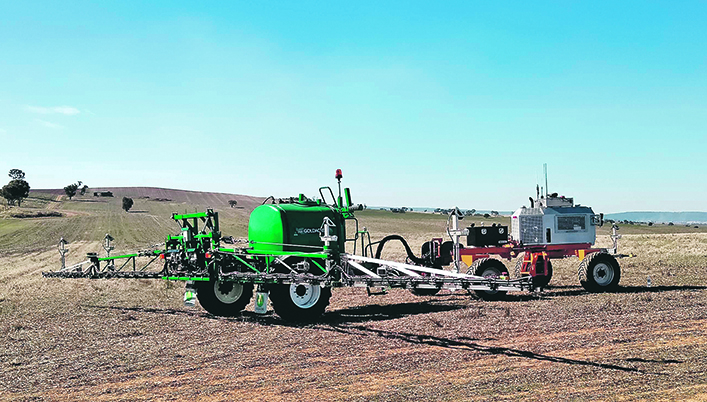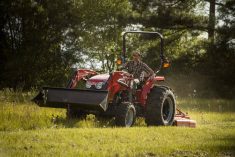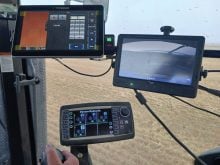Reliably identifying green weeds among a green crop has long been a goal for spot spraying herbicides
There’s a race to build computer programs that instantaneously differentiates weeds and crops within images taken by sprayer-boom mounted cameras.
Green-on-brown spraying, where cameras identify plants on brown soil background for burndown applications, has been around for at least 15 years.
Weed-It, John Deere See & Spray Select and Amazone AmaSpot can all target individual weeds and can provide effective burndowns with a fraction of the herbicide used in a blanket application.
Green-on-green spraying, where weeds are identified and sprayed in crop, is much more difficult.
Read Also

Growing garlic by the thousands in Manitoba
Grower holds a planting party day every fall as a crowd gathers to help put 28,000 plants, and sometimes more, into theground
Many companies are working on this but it’s difficult to get the weed-kill rate into the low to mid 90 percent range, which is required to make the systems compete with blanket herbicide applications.
However, a green-on-green capable system is already commercially available in parts of Australia.
Bilberry, based in Gentilly, France, says it can achieve a 90 percent kill rate of broadleaf weeds in cereal crops, and the company is improving its AI-based algorithms to identify more weeds in many crops including canola.
“We are about or around 90 percent hit ratio, so we hit about 90 percent of the weeds,” said Guillaume Jourdain of Bilberry.
“The number one reasons why we missed some is because they are shaded by the crop. So basically the cameras are looking through crops and sometimes the crops will shake or it will be in front of the weeds, so that we just block the view from the camera.”
The company started as a project at a French engineering school in 2014 by Guillaume Jourdain, Hugo Serrat and Jules Beguerie.
Through conversations with farmers the team became aware that herbicide resistance is a major problem around the world and that in-crop spot spraying would be a handy tool to have in the fight.
“At that time it was really the beginning of artificial intelligence embedded in vehicles, in a very broad way. Before it was very difficult to solve all the technological challenges that exist for spot spraying. But with AI and the rise of embedded systems, really we were at the right time to work on this and try to finish the solution,” Jourdain said.
The Bilberry system has a camera every three metres on the boom, and each camera has a dedicated processor that sends the information to a central computer in the sprayer’s cab.
“From there, we send the information to the nozzles to open them and close them in real-time, so individual nozzle control. Obviously, we are also linked to the GPS so we also have a section control that’s working,” Jourdain said.
“Normal speed for us to be about 20 km-h. It can be a bit faster, but 20 km is where we are very comfortable.”
Training machine learning algorithms is a long and tedious process.

Bilberry started by driving fields with sprayers and four-wheel drive vehicles equipped with cameras.
The images were then labelled by manually identifying the plants in the photos, and then the AI training process could begin.
“AI training means basically showing the labelled images to the algorithm several hundred or thousands of times so that it can start learning what the weeds are, what the crop is, and then in a new situation it will be able to say, ‘OK, that’s a weed or that’s a crop’,” Jourdain said.
Bilberry is working with multiple spraying manufacturers including Agrifac from the Netherlands, but also with Canadian operations, and has research projects underway including with Goldacres, an Australian manufacturer and supplier of agricultural spraying equipment.
Goldacres recently built a sprayer that uses Bilberry’s spot-spraying program, and is towed by a SwarmFarm Robotics platform.
SwarmFarm, also Australian, produces a range of robots including Uniform, a fully autonomous unit powered by an 83 horsepower, Hatz four-cylinder diesel engine, that has a hydraulic drive with articulated steering and a top speed set to 10 km-h.
The Uniform robot tows the custom-built Goldacres sprayer, which is fit with a Raven controller and Bilberry’s spot-spraying system.
Jourdain said Bilberry is a hardware integrator rather than a hardware developer.
“There are great hardware manufacturers all over the world. So it’s better for us to let them invest in that and we just buy new things every year. Then on the software and AI side, we get inspired by the state of the art, and then we develop everything in house. We’ve got developers to do that,” Jourdain said.
He said the Bilberry system works well with many kinds of equipment and cameras, and that the company is focused on working to integrate their program with multiple equipment manufacturers.
Bilberry is running trials in Europe and the United States and plans to start trials in Canada soon.
“Hopefully we can have the first trials this year (in Canada). So 2021 is the first trials with the (Agrifac) machine that we’ve got there. Hopefully next year we can have a not a full commercial rollout, but we can have a few growers that can start using the technology,” Jourdain said.


















